INDUSTRIAL & OFFLINE
TERMINAL RAILROADS &
RAIL-MARINE OPERATIONS
OF BROOKLYN, QUEENS, STATEN
ISLAND, BRONX &
MANHATTAN:
WEST 26TH STREET
FREIGHT STATION
Manhattan
BALTIMORE & OHIO RAILROAD
Twenty Sixth Freight Stores Warehouse
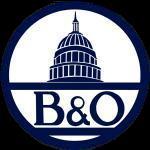
..
.
|
updated: |
||
|
|
||
|
update summary: |
date: | chapter: |
| 1932 images of #316 added | 1/18/2022 | Locomotive Overview & Photos |
.
.

| Property & Trackage | Float bridges | |
| Locomotive Overview & Photos |
Marine Equipment Overview & Roster |
|
| Memorabilia |
.. ..

1924 Army Air Service
courtesy of T.
Flagg
added 27 June 2009
There are some contradictions as to when the West 26th Street Freight Yard first opened.
It is believed the property was leased by the Baltimore & Ohio Railroad prior to 1898. The Joint Report with Comprehensive Plan and Recommendations of 1920, issued by the New York & New Jersey Port & Harbor Development Commission, states the yard "came into service in the 1890's"..
Returning to the actual West 26th Street Freight Station and according to Tom Flagg, the float bridge construction date as disclosed by Baltimore & Ohio Railroad engineering department records was 1898. Therefore it is believed this yard went into operation the same year or at the latest, the year after.
The Baltimore & Ohio Railroad Employees Magazine reported in 1914, that the railroad purchased the West 26th Street property in 1911 for the sum of one million dollars.
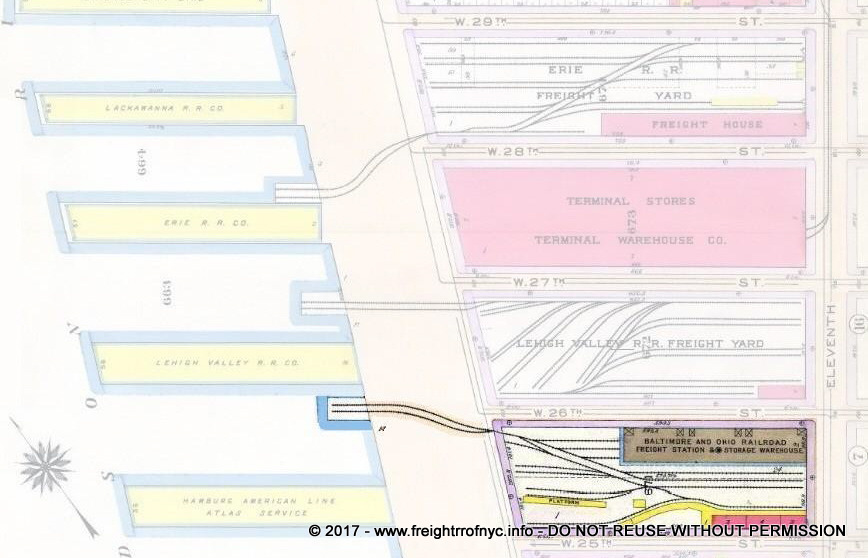
1915 - G. W. Bromley
(revised by author)
.
The Baltimore & Ohio Railroad's West 26th Street Freight Station, was the southernmost of the four offline terminals located in Manhattan (keep in mind I do not consider the New York Central Railroad's operations to be offline).
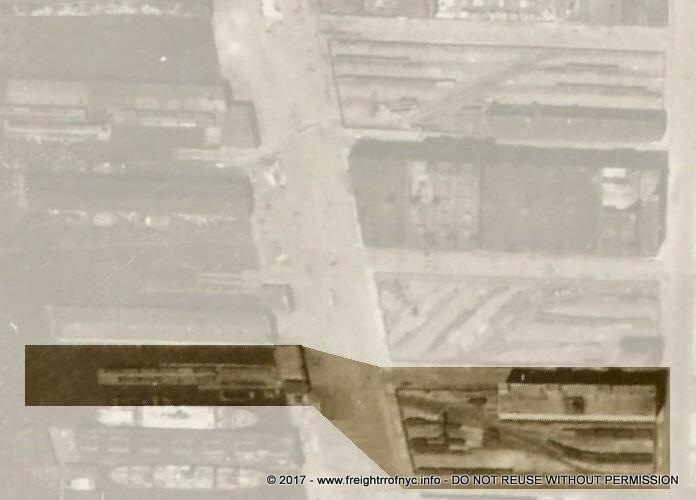
Fairchild Aerial Survey Photo - 1924
NYPL Digital Archives
.
According to the 1920 Joint Report with Comprehensive Plan and Recommendations by the New York, New Jersey Port and Harbor Development Commission; the following figures are given.
Baltimore & Ohio Railroad - West 26th Street
|
tonnage handled |
... |
cars handled |
... |
cars handled |
||||||
| inbound |
outbound |
total |
loaded |
empty |
total |
loaded |
empty |
total |
||
|
|
|
|
||||||||
| 74,465 |
32,393 |
106,858 | 5,385 |
2,075 |
7,460 |
3,275 |
4,185 |
7,460 |
||
.
Unlike the neighboring offline freight terminals to the north (Lehigh Valley Railroad West 27th Street, Erie Railroad West 28th Street and Pennsylvania Railroad West 37th Street), this facility did not have an associative use with any of piers on the Hudson River.
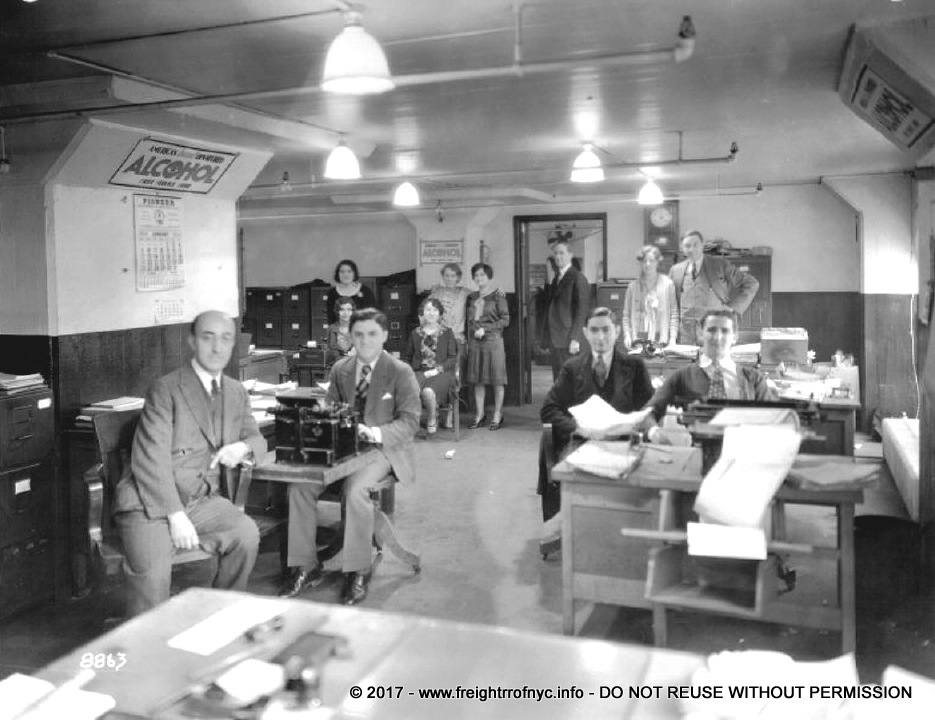
Baltimore & Ohio West 26th Street Freight Office
Staff - circa 1928
Baltimore & Ohio Railroad Valuation photo
E. Bommer collection
added 26 December 2011
Ed adds this: in the 1920s, my cousin (my paternal grandmother's sister's daughter) Katherine Shantz worked in the Baltimore & Ohio Railroads freight office at West 26th Street. She's the standing woman to the right, in a light colored dress (in front of the clock).
Railroad / carfloating service to this facility was eliminated circa late 1973 - early 1974.
The property went on to serve as a freight facility handling tractor trailers for a few years afterwards..
.
.
The Baltimore & Ohio Railroad West 26th Street Freight Station underwent many phases of development throughout its history.
Taking my lead from Tom Flagg, who denoted these phases to an extent in Transfer Issue #27, I have found additional phases of property construction which are included here..Please use the Phase Index to "jump" to a particular phase. Some dates are not exact and will be revised upon further research.
|
.. |
.
The trackage layout of the West 26th Street Yard when first opened would be relatively simple in design. Fortunately, Tom Flagg has already taken great pains to assemble a rather comprehensive collection of property maps which will suffice in lieu of actual track maps.
Please keep in mind that property maps, while quite detailed; have inaccuracies in regards to track layout.
In the map below, a locomotive pulling freight cars off the carfloat would pull them east into the yard, and be able to shunt those cars onto either of the four tracks in the left (west) portion of the yard. However, with the locomotive on the east side of the train (as it would be pulling cars off a carfloat), it would become trapped behind those freight cars if placing them on the tracks in the right or east portion of the yard.
Therefore, this yard must have had a runaround track that is not denoted or the cars were "poled" into position from and adjacent track.
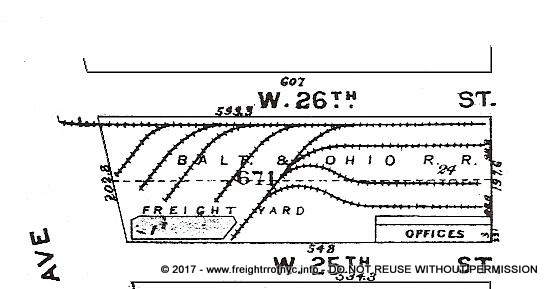
1912
(unattributed)
courtesy of T. Flagg
added 17 May 2009
.
| Main Index | Property Phase Index |
.
.
By the time the G. W. Bromley property map was revised in 1915 (see below), the trackage layout had changed dramatically in the yard. Judging from that 1915 property map below, it is quite apparent that the Baltimore & Ohio Railroad extensively rebuilt this facility between this 1915 edition and the preceding 1912 edition above. Research by Tom Flagg gives this yard reconstruction date as 1914.
1914 was also the year that the ten story white "Baltimore & Ohio RR 26th St. Stores" structure was built in the northeast corner of the property. This structure required the reconstruction of the yard, and the track layout apparently changed at this date. It is quite clear the yard was substantially reconstructed, with very little if any of the original track layout remaining. The reconstruction allowed for greater flexibility of the trackage and allowing for the Baltimore & Ohio Railroad 26th St Terminal Stores to be constructed.
The following two photos were taken by the same photographer (P. L. Sperr) and taken roughly three months apart. Both are looking due east.
|
|
... |
|
.
.
Ed Bommer furnished these images on 25 December 2011:
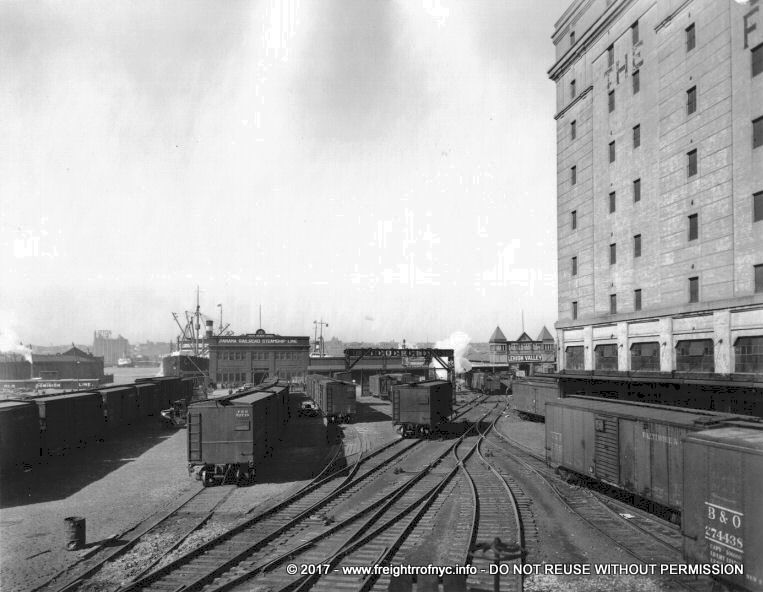
Baltimore & Ohio West 26th Street Yard - unknown
date
(looking west)
Baltimore & Ohio Railroad Valuation photo
E. Bommer collection
added 26 December 2011
.
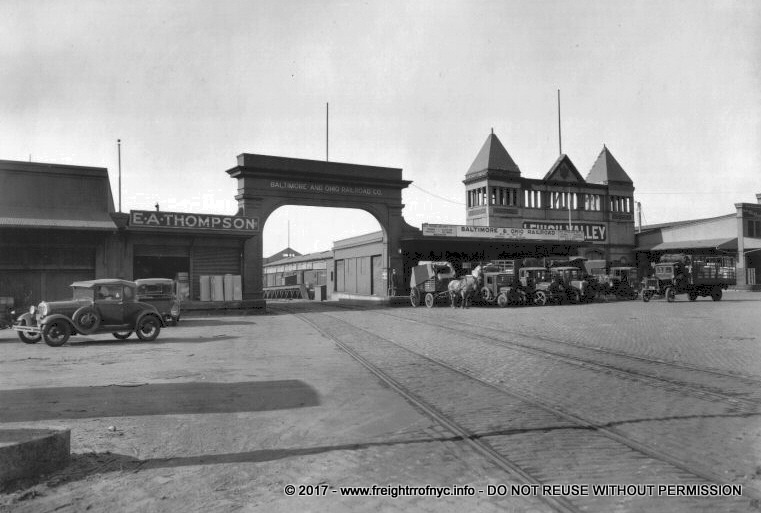
Baltimore & Ohio West 26th Street float bridge
lead - unknown date
(looking west)
Baltimore & Ohio Railroad Valuation photo
E. Bommer collection
added 26 December 2011
.
The original freight house / offices can be seen in the lower left (southeast) corner of the property. According to the legend on the Bromley map index, pink structures denote brick construction, yellow structures are wood frame construction, stone / concrete construction in light brown, and iron or metal sheathed wood construction is yellow with blue outline (i.e. pier).
I have included these construction types to give the reader a better sense of the many types of structure compositions that existed in these freight terminals.
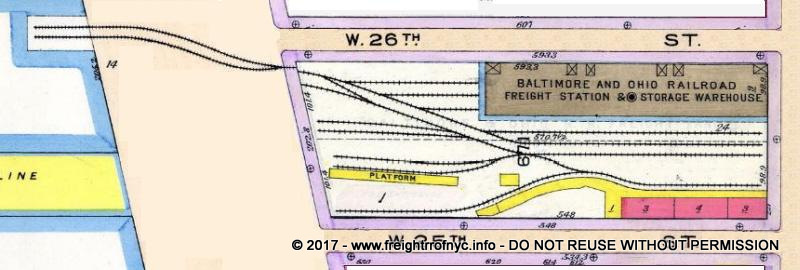
1915 - G. W. Bromley
(revised by author)
added 17 May 2009
.
There was a platform located just off the east - west center line of the property on 12th Avenue, and somewhat crescent shaped one story structure along the south property edge bordering on West 25th Street. This crescent shaped structure is no longer visible in in the 1924 aerial, but an overhead gantry is just north of the platform on Eleventh Avenue.

1930
courtesy of T.
Flagg
added 17 May 2009
.
In comparing this 1930 property map to the 1915 property map above, not many changes have taken place in those last fifteen years, however we see the original offices which were located at the southeast corner of the property were razed. (This structure is seen in the 1912 map marked "offices" and 1915 map marked in pink). A siding was installed were this building once stood.
| Main Index | Property Phase Index |
.
.
In the early 1930's, the Baltimore & Ohio Railroad greatly expanded their presence in Manhattan by acquiring the block immediately south of the original yard. This new property acquisition is believed to have occurred between 1931 and 1933, which in itself is a slightly unusual time frame to choose for an expansion, as this was the height of the Great Depression.
A diagonal street crossing was necessary to cross West 25th Street and some trackage was installed on the block bound by West 24th and West 25th Streets, Eleventh and Twelfth Avenues.
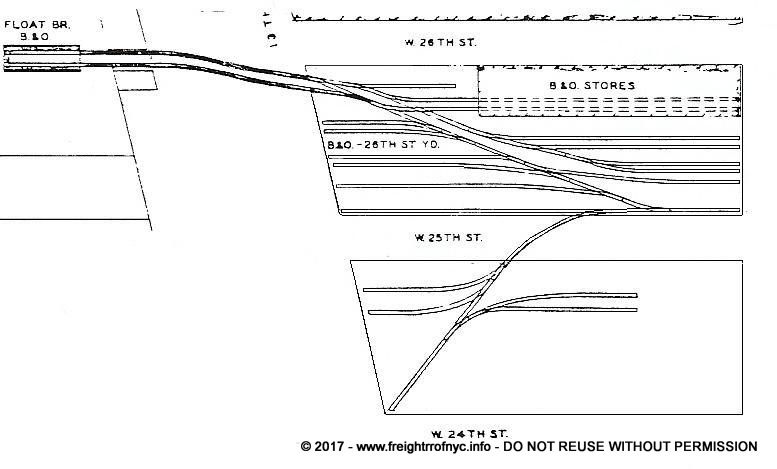
1933
courtesy of T. Flagg
added 17 May 2009
..
| Main Index | Property Phase Index |
.
.
Tom Flagg furnished the following blueprint map (along with many others) during a research meeting on 10 June 2009 with Joe Roborecky and myself.
This particular blueprint is interesting as it shows the proposed Twelfth Avenue Freight House and "new" yard trackage extending all the way to Eleventh Avenue, which we can tell by images below did not occur at the same time with the construction of the Twelfth Avenue Freight House.
This date of this blueprint has been obliterated through age (it might have appeared in the bottom right corner), and one only needs to look at the edges of the blueprint to see why. We are fortunate to have this historical document survive, and we owe our thanks to Tom.
Click on the small version below to view a large scale high resolution version of this image. The large scale image is huge (9.1 megabytes), so please be patient while it opens! Use the back arrow on your web browser to return you here as there is no return link provided.
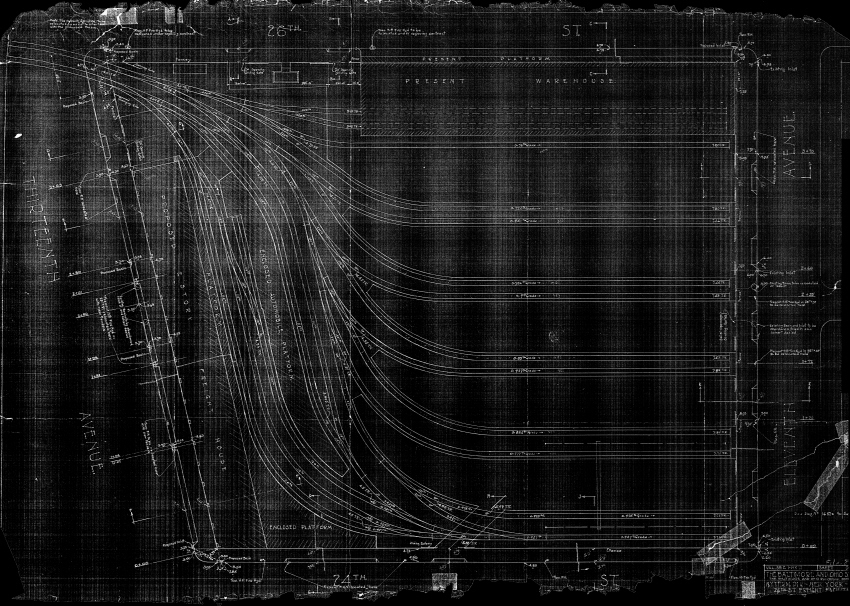
ca. 1935
courtesy of T.
Flagg
added 13 June 2009
.
By 1935, West 25th Street between Eleventh and Twelfth Avenues was removed altogether from the city grid, and the Baltimore & Ohio Railroad built the north - south oriented freight house and loading docks that ran parallel along Twelfth Avenue. A portion of this Twelfth Avenue Freight House can be seen in the image below. (The back wall of this structure can be seen in another image several paragraphs below.)
The following photo, was taken circa 1937 and I believe the photo below to have been taken from the southwest corner of Starrett - Lehigh Building, at the same time the aerial view image of the original pony truss float bridge was taken (seen in the float bridge chapter).
Immediately noticeable, is how short the curved yard trackage is. This is due to the structure that can be seen in the upper left corner of the photo. This structure was a garage, as marked in a 1915 G. W. Bromley Property Map.
Yet the blueprint above shows the trackage to extend to Eleventh Avenue! Because the date in no longer visible on the blueprint, it is unconfirmed if in fact it is dated 1935, but regardless, that square garage was razed around mid to late 1930's, and the yard trackage lengthened considerably to Eleventh Avenue; thereby increasing track capacity and subsequently, allowing the freight house fronting along West 24th Street to be constructed.
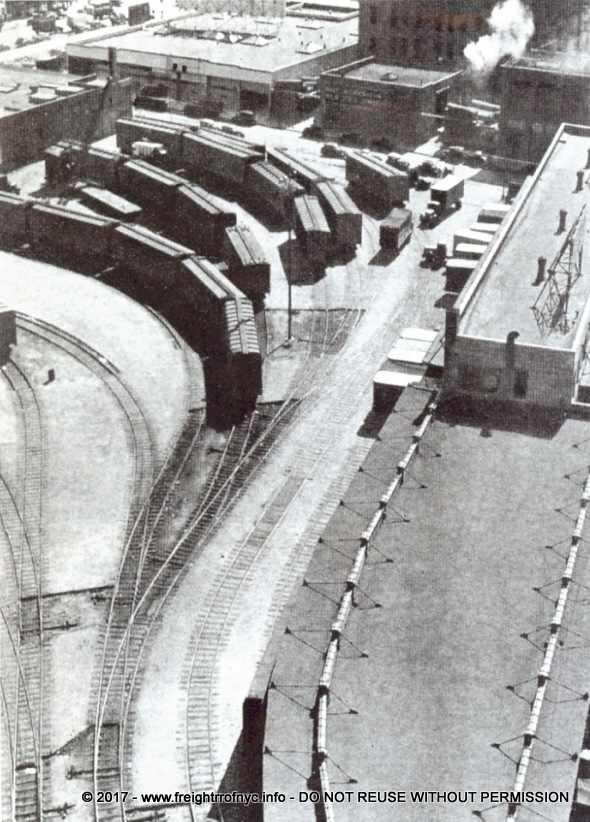
West 26th Street Freight Station - Twelfth Avenue
Freight Station (right) - 1937
Looking south. Lower half: B & O Freight Station; upper half: Seaboard
Freight Lines.
Note the rail crane in upper left corner by flatcar.
Model Builder November / December 1937 photo
via T. Flagg
added 17 May 2009
.
.
I took some time and modified the 1955 property map to better reflect how the yard, track and structures would appear in the 1937 image above. I would not hold this map to 100 percent accuracy, as some of the trackage in the photo above is either in shadow, blocked from view by freight cars or under the roof overhang of the freight house. The actual dimensions of the "garage" are estimated as well.
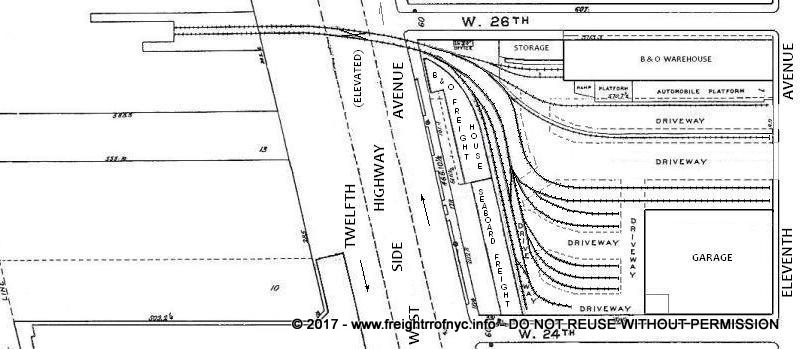
1937
authors
rendition
added 17 May 2009
.
.
On 30 June 2009, I happened across three photos of the Twelfth Avenue freight house that I had not come across before, despite several searches of the New York Public Library Digital Archives. All three were taken by P. L. Sperr, dated August 24, 1940 and show the Twelfth Avenue Freighthouse from different angles.
|
|
| .
. |
|
|
| .
. |
|
|
.
.
.
The Twelfth Avenue Freight House, as seen in the image below; comprised of two structures: the northern portion (closest to West 26th Street) being the actual Baltimore & Ohio Freight Station, was approximately 1½ stories tall, with a covered loading platform along the rear wall for shelter while loading / unloading freight cars.
The first tenant for the southern portion (or portion closest to West 24th Street) of the Twelfth Avenue Freight House was Seaboard Freight Lines, a freight consolidator & forwarder. This part of the structure was a full two stories tall.
Their signs, which were mounted on tall steel lattice framed billboards, can be seen both in the 1937 photo above, and the 1938 photo below in the B & O 26th Street Stores chapter below. In that 1938 photo, the Seaboard signs are visible just above the West Side Highway railing, and their trucks can be seen backed into the loading docks at the Twelfth Avenue Freight House under the West Side Highway.
It is unknown when Republic Carloading took over tenancy of this portion of the Twelfth Avenue Freight House.
.
| Main Index | Property Phase Index |
.
.
There are two aerial photos available in chronological order to this chapter. One is a Fairchild Aerial Survey (oblique) dated July 7, 1951; and the other is from the United States Geological Survey (overhead) and is dated 1954. Both images below, show the "newest" freight house, the one along West 24th Street.
This new freight house was located in the southeast corner of the property at West 24th Street and Eleventh Avenue, and was oriented east - west. The location of this new freight house is somewhat upon the south edge of the square "garage" structure in the 1937 map above.
This newest freight house, which was narrow and elongated, would allow the team tracks to be lengthened, yet would allow the Baltimore & Ohio Railroad to retain a total of three structures for handling freight: (the B&O Stores, the Twelfth Avenue freight house and now this West 24th Street freight house.
This 1951 Fairchild Aerial Survey Photo is quite large and packed with detail. Note the B&O Warehouse in now marked with the name A. O. Feidelson. Also, the roof of the boxcab diesel locomotive can be seen just north of the Twelfth Avenue Freight House at the yard entrance.
Please click on the image below to see a large version of this photo. Use the back arrow on your browser to return you here.
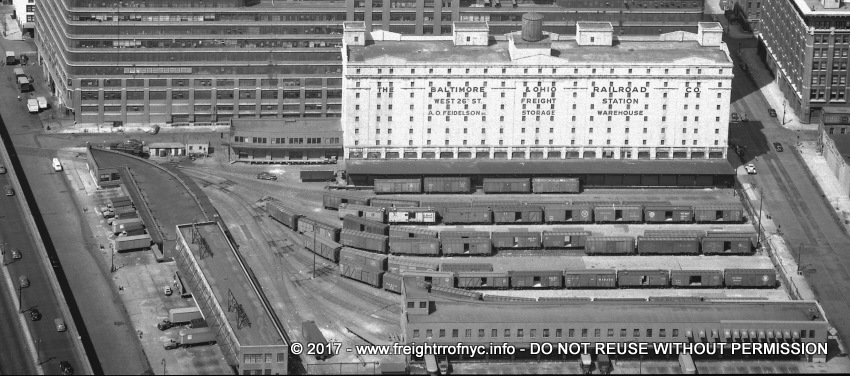
Fairchild Aerial Survey Photo - July 7, 1951
New York State Library Digital
Archives
added 30 June 2009
.
.
The next image is the United States Geological Survey.
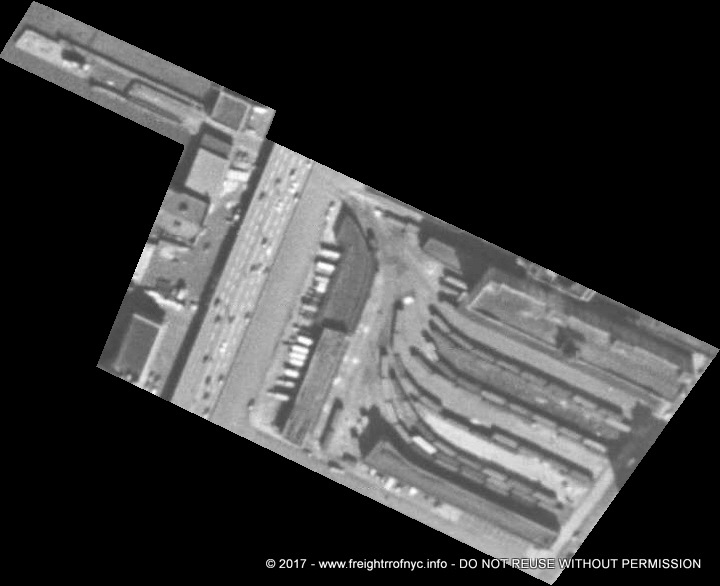
United States Geological Survey - 1954
.
The G. W. Bromley property map of 1955 (seen immediately below), shows the yard tracks very closely corresponding to the aerial photo above.
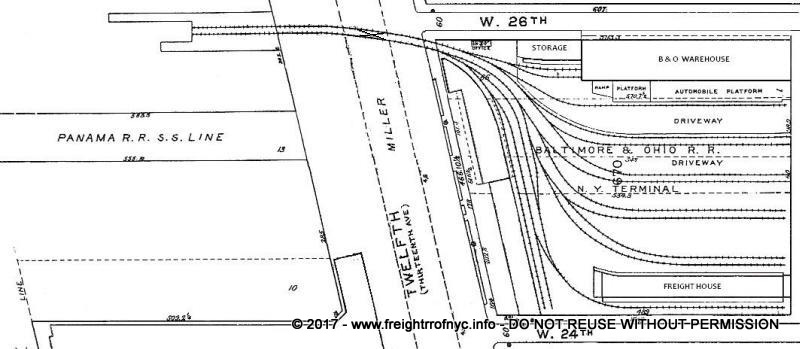
1955
courtesy of T. Flagg
(clarified & modified by
author)
added 17 May 2009
.
The property footprint, as shown in the 1955 Bromley map above and after the Baltimore & Ohio "annexed" the city block (bound by Eleventh and Twelfth Avenues, West 24th and 25th Streets) would be: 594 feet along West 26th Street, 455 feet along Eleventh Avenue, 489 feet along West 24th Street and 467 feet along Twelfth Avenue, for a aggregate total of 249,631 ½ square feet or a little under 5 ¾ acres.
The following image, taken 1958; shows the Twelfth Avenue Freight House transfer platform and structure, as well as a portion of the Republic Carloading structure. Quite apparently, Republic Carloading has already taken over occupation of the southern portion (or right side of the building in the image below) of the Twelfth Avenue Freight House from Seaboard Freight Lines.
Republic Carloading was a "less than carload consolidator", which means they took small lots of freight from different consignors and bunched them up into a single freight car, thereby reducing the shipping rates. Example: if several different customers each had a small amount of freight going to Chicago, those lots of freight would grouped together and be consigned to a single boxcar. The same would be done for less than carload freight destined for other major rail terminal (shipping hubs) throughout the United States..
The next image, shows the east (back) wall of the Twelfth Avenue Freight House, which was the railyard side. This image is dated 1971, and was taken by Tom Flagg.
The Atlantic Coast Line boxcar (faded round emblem) of left edge of photo and the Northern Pacific (NP) boxcar are on the track closest to the freight house and would be in a position to be loaded / unloaded directly into the freight house.
The diagonal braces attached to the wall of the freight house and appearing to connect to the boxcars is actually suspending the corrugated steel awning covering the loading platform, which is mostly hidden behind the roofline of the boxcars; and of which a small glimpse of the awning can be seen between the Atlantic Coast Line and Nickel Plate boxcars.
The string of four boxcars to the right of the Nickel Plate boxcar could be accessed via bridge plates through the string of boxcars on the inner track.
The chimney visible above the boxcar on second track is the northern most edge of the second story wall of Republic Carloading. At this point the roof line dropped a half story (eight or so feet) to become the roof of the Baltimore & Ohio Railroad Freight House.
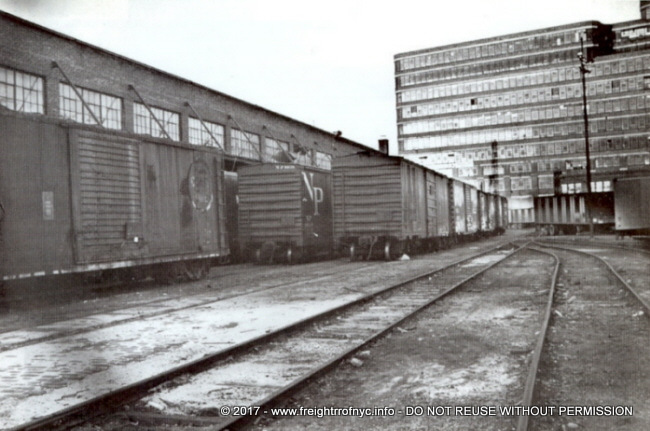
West 26th Street Freight Station - Twelfth Avenue
Freight Station; back wall of Republic Carloading - 1971
Looking north with Starrett - Lehigh Building in background.
T. Flagg photo
added 18 May 2009
.
| Main Index | Property Phase Index |
.
.
Another extensive modification to the West 26th Street facility took place between 1954 and 1966. Yet another freight house would be constructed, this one parallel to Eleventh Avenue and connecting to the West 24th Street freight house, forming an "L'.
Roughly in the center of this new freighthouse, a covered platform would extend towards Twelfth Avenue, essentially forming a "cul-de-sac" around the now five sidings within. With the boxcars on these five sidings aligned with each other, and with the use of bridge plates joining the open doors, workers could access the boxcars from either the covered platform or the West 24th Street Freight House.
A large courtyard gave access to tractor - trailers which could back up to the covered platform and transfer freight directly to or from the boxcars.
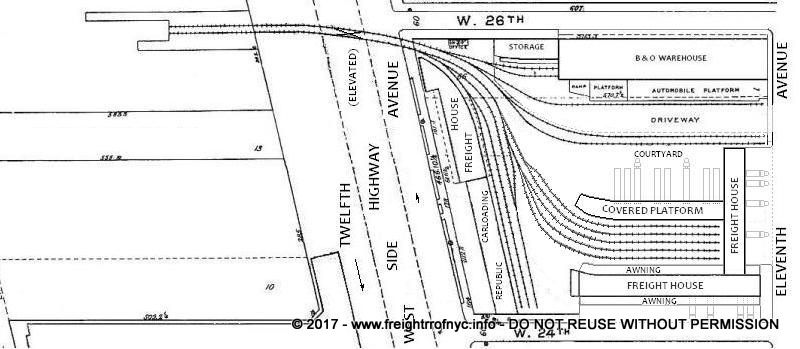
1966
authors
rendering
added 17 May 2009
..
This new freight house along Eleventh Avenue, was two stories tall, and can be seen in the 1974 Tom Flagg image below; as the row of tiny square windows seen about halfway down the left edge of the image and extending about a third of the way right. The curved covered platform can be discerned just above the row of trailers.
I have made minimal notations to the image below to assist the viewer in locating these final additions to the West 24th Street Freight Station.
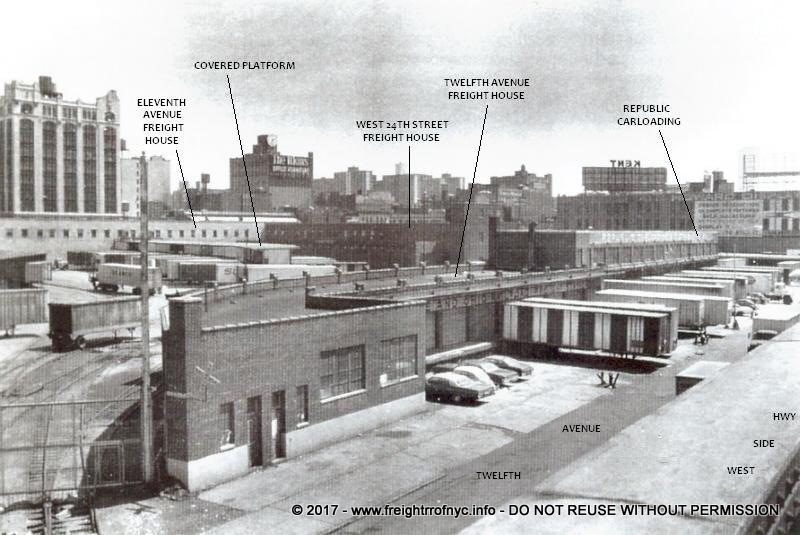
West 26th Street Freight Station - Twelfth Avenue
Freight Station (left) with Republic Carloading (right) - 1974
Looking southeast and down from upon West Side Highway.
Rail service ended the year before.
T. Flagg photo
added 17 May 2009
.

West 26th Street Yard Entrance - 1974
Panning left from above photo, looking east southeast and down from upon
West Side Highway.
Tracks at bottom ran under the West Side Highway and behind photographer
to float bridge.
Note tractor trailers blocking tracks and track flangeways filled with
dirt.
Rail service ended the year before.
T. Flagg photo
added 17 May 2009
.
Even though rail and carfloating service ended at this facility in late 1973 or early 1974, most of the structures remained standing, and can be seen in a 1979 aerial photo. A great deal of tractor - trailers are still occupying the yard in this aerial and many are seen backed into the various loading docks and platforms.
By 1987, all but one of the structures razed, that being the original B & O 26th Street Stores occupying the corner of Eleventh Avenue and West 26th Street. It remains as of 2017, albeit hemmed in by modern construction.
| Main Index | Property Phase Index |
.
Baltimore & Ohio R.R. 26th St Terminal Stores
|
These two tracks had a capacity of eighteen 36 foot freight cars (the standard length of that era). The building was also equipped with an exterior loading dock and automobile ramp by outdoor tracks just outside the south wall. The internal design of the building was unique, as it contained a mezzanine between the ground floor and the second floor. This mezzanine took up the space between the ground floor and the second floor due to the height of the internal freight car tracks On floors two through nine, the building was divided into thirds with firewalls separating the sections. The tenth story was nothing more than four cupolas, located along the roof line of the north (West 26th Street) wall, and are referred to as "penthouses" in the architectural drawings. |
The Baltimore & Ohio Railroad, as stated above, constructed
a ten story white structure, known as the Baltimore & Ohio Railroad 26th
Street Stores and was located in the north east corner of the terminal property
& Yard.
This handsome white edifice was designed by M. A. Long working under the Baltimore & Ohio Railroad chief engineer F. L. Stuart. The 26th Street Stores was constructed of concrete and built by Turner Construction, a notable building firm in the New York City area and remains in business to this day. The final building dimensions were 352 feet (east - west) by 67 feet (north - south) and was completed in 1914. This structure would have two internal tracks, running the full length of the structure, just inside the south wall. The ground floor was elevated to the height of the floor of freight cars (as a loading dock should be). The following image shows the two internal tracks, the loading dock and the mezzanine windows above the loading dock of the left, and the corrugated steel awning on the right (south face of building)
|
Normally, I do not include blueprints or drawings of the major structures at these rail terminals, but the aesthetic and historical nature of this structure and unique design, warrant display in this case.
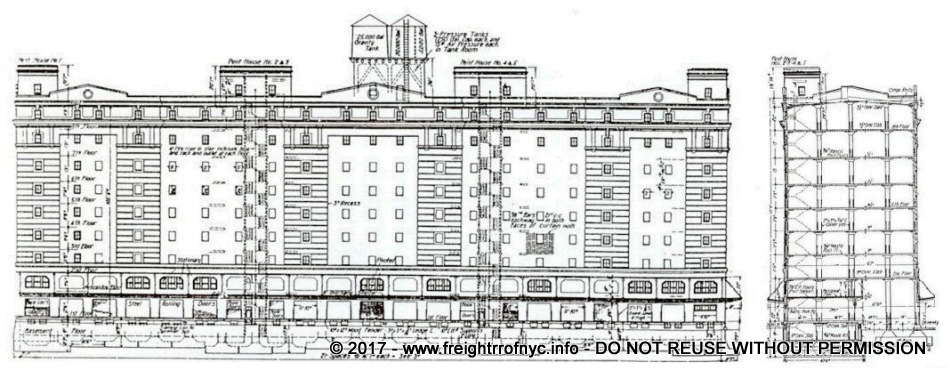
side elevation
cross section
Looking north.
Looking west.
Railway Review, May 16, 1914
via T. Flagg
added 16 May 2009
.

floor plans
Railway Review, May 16, 1914
via T. Flagg
added 16 May 2009
.
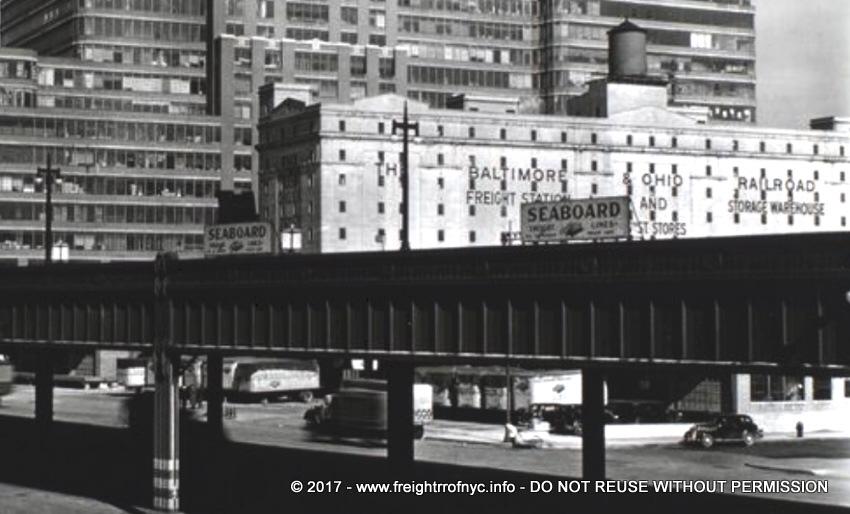
Baltimore & Ohio Railroad 26th Street Stores -
March 1, 1938
Looking northeast.
B. Abbott photo
NYPL Digital Archives
added 19 May 2009
The original float bridge installed at the Baltimore & Ohio Railroad West 26th Street Freight Station was originally a pontoon supported steel pony truss. According to Tom Flagg's research of Baltimore & Ohio Railroad Engineering Department records, this float bridge was constructed in 1898.
The image below, furnished by Tom; is circa 1937 and apparently was also taken from the Starrett - Lehigh Building, as was the image of the railyard, which can be viewed in the Property & Trackage chapter above.

ca. 1937
Looking west.
Model Builder November / December 1937
photo
via T. Flagg
added 17 May 2009
..
This pony truss float bridge was apparently well constructed, as it served this facility for more than half a century and a 1954 aerial photo taken by the United States Geological Survey shows the two truss steel bridge still in place. But around that same year, this pony truss float bridge would require replacement.
|
|
The Baltimore & Ohio Railroad decided to replace the original steel pony truss float bridge with a newly built wood Howe Truss float bridge. This was an unusual move for the day, as the design and wood construction of the Howe Truss dates back to the 1800's. Tom Flagg notes that Howe Truss float bridges are inherently better suited for use in salt water climates, and are more flexible in regard to torsional loads. Unfortunately, Howe Truss float bridges are significantly more expensive and time consuming to construct, so it is no wonder why the railroads evolved away from them. But as we can see, the Baltimore & Ohio Railroad went "against the grain" so to speak, and installed a technologically older design.
|
| .
. |
|
|
|
|
.
It appears from several images taken of the West 26th Street Float Bridge, that the Baltimore & Ohio Railroad incorporated a policy of blocking the float bridge approach tracks with boxcars located side by side. This undoubtedly prevented automobile drivers from erroneously turning down the approach and driving off the float bridge:
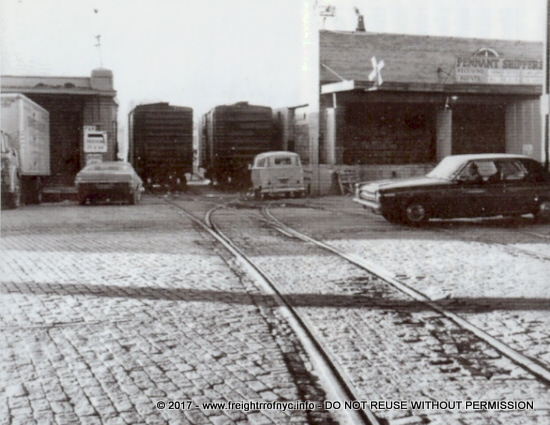
West 26th Street Howe Truss Float Bridge Approach blocked
by boxcars - 1971
Looking west.
T. Flagg photo
added 17 May 2009
.
To date, I have not run across any images of the other offline terminals located in Manhattan utilizing this "boxcar barricade" in front of their float bridges. This leaves us to wonder, did this type of accident occur at this location, when some errant nitwit drove his Packard off the float bridge?
Upon cessation of rail / carfloat service to this facility circa late 1973 / early 1974, the West 26th Street float bridge was maintained on standby service then abandoned in place. Because of the wood construction, the float bridge was able to withstand the corrosive effects of salt water, and therefore stood up better than a steel bridge would have, and the float bridge structure would suffer minimally from the effects of such a harsh marine climate, even in an abandoned state.
Here is a photo of the Howe Truss float bridge as it appeared in 1976.
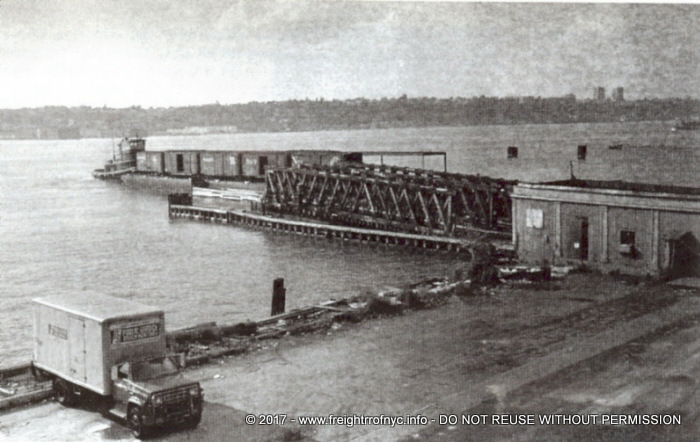
West 26th Street Howe Truss Float Bridge - 1976
Looking northwest.
T. Flagg photo
added 18 May 2009
.
In the photo above, (according to Tom Flagg's notes in Transfer #27) we are viewing the Baltimore & Ohio Railroad vessel "Roy B. White" removing a platform carfloat from the bulkhead immediately north of the float bridge. But it has been previously been stated that the West 26th Street Freight Station closed circa 1973. So, why the discrepancy in dates?
Well, according to Tom Flagg; there was a minuscule structure (authors estimate about 50' x 50') located on the bulkhead that a freight forwarder occupied. This freight forwarder was the last business to receive service from the Baltimore & Ohio Railroad in the West 26th Street area. This freight forwarder would receive less than carload consignments via the platform carfloats. The structure appears too small to store the amount of freight consignments that would be contained in the five plus boxcars visible, so Tom hypothesizes that the consignments were most likely transferred out of the boxcars directly to trucks.
Returning to the history of the float bridge; what makes this "retro" float bridge replacement even more ironic, is that this very Howe Truss float bridge survives to this day, in excellent condition, having been restored in the early 2000's. While the pontoon needed to be rehabilitated (it developed a leak as to be expected and sunk, and according to Paul Strubeck, the pontoon does not actually support the float bridge any longer but rests on piles).
But for the most part, the creosoted timber structure held up well through the ravages of time and tide. The historic value of this remaining Howe Truss float bridge was eventually recognized (thanks to Tom Flagg!) and was designated eligible for the New York State Register of Historic Places.
The float bridge served as a floating kayak launching station (according to Paul Strubeck this is no longer the case). A linear park was constructed along the West Side waterfront in 2006 and you can walk almost completely around the float bridge as well as on it and view it from any angle (which is normally not an option to do so safely from the waters side).
Also according to Paul, and confirmed by a consulting engineer with the New York State Office of Historical Preservation, the West 26th Street floatbridge is not supported by it's pontoon, but in fact the pontoon rests on large boulders (large fill) and pilings.
Having such unprecedented access to a float bridge of this design in safe condition is a rarity; and gives modelers and historians an unusual opportunity to view first hand the construction methods and appliances used on a pontoon style float bridge of this type.
This float bridge retains most of its original mechanical appurtenances (winches, toggles, float bridge jack, pontoon, etc.) and I highly recommend anyone interested in Offline Terminals and / or float bridge construction to pay a visit to this location should you be in New York City.
The following images were taken by the author in August 2006 when the linear park was still under construction. With the exception of the minimalist cable type safety handrail and construction debris, this image could pass for being taken anytime after 1954!
|
|
|
| .
. |
|
|
|
|
| .
. |
|
|
|
|
| .
. |
|
|
|
|
| .
. |
|
|
|
|
| .
. |
|
|
|
|
| .
. |
|
|
|
|
| .
. |
|
Please take note, Baltimore & Ohio Railroad renumbered and reclassified their locomotive rosters several times over their history. In some the cases, the same locomotive may have operated at West 26th Street wearing two different numbers. That being the case, I have attempted to keep the photo archives below in chronological order.
We know of many locomotives that operated at the Baltimore & Ohio Railroad's West 26th Street facility.
.
#316
The only known steam locomotive to date that is confirmed to have operated at West 26th Street, is #316. This locomotive was an 0-6-0T equipped with a steam dummy shell. This locomotive started as 0-8-0 locomotive & tender #243 in August 1865 and was built by the New Jersey Locomotive & Machine Works, located in Paterson, NJ.
In October 1886, #243 was rebuilt at the Baltimore & Ohio Railroad's Mount Clare Shops to an 0-6-0 locomotive and tender, (D1 class) and renumbered 316.
It was rebuilt yet again in February 1898 by Mount Clare Shops to an 0-6-0T, specifically with the intent to be used at the West 26th Street Freight Station in Manhattan. It was (re) constructed as a "steam dummy" so it may work around the horse drawn wagons and teams, without frightening them unnecessarily.
Upon the arrival of diesel box cab #1 at West 26th Street (in response to the anti-smoke ordinance enacted by the City of New York in 1925); #316 continued served the Baltimore & Ohio Railroad at their St. George Yards and switched at American Dock Company (!) in Staten Island. It would intermittently return to Manhattan, when #1 would require maintenance or servicing, and would be seen in Manhattan as late at 1937, and possibly 1939.
As of 1939, #316 would be the oldest operating locomotive in the U.S. on a Class I railroad. #316 would not be scrapped until September 1946.
As #316 has a most interesting history associated with it, Ed Bommer (B&O RR historian) was kind enough to compose a detailed history of that locomotive for this website. That detailed history may be viewed here as a .pdf file. Please use the back arrow on your web browser to return you here as there is no return link: The Life of B & O #316, by Ed Bommer
.
#75
. On Christmas Day, 2011; I was rummaging through my late fathers collection of railroad books which were packed in crates. I happened across the book "Locomotives & Cars Since 1900", by Walter A. Lucas; Simmons-Boardman Publishing, 1959. This book had been in my father's collection for as long as I can remember, and I just happened to pick it up and start thumbing through it. On Page 5 is a photo of Baltimore & Ohio 0-4-0T #75. Naturally I gravitated towards studying the image in detail as it was of a saddletank type switching locomotive. What caught my eye however, is the background of the photo, with what appears to be the original style piershed that was once located along the West Side of Manhattan!
Unfortunately, not enough of the façade is visible in the photo to irrefutably confirm the location of the photo, but the locomotives orientation to the structure (perpendicular) corresponds to the West 26th Street Freight Station, where street trackage crossed Twelfth Avenue (pre-West Side Highway) with a truck behind the locomotive and the piershed head house fronting along Twelfth Avenue. The sign on the structure is clearly marked Baltimore & Ohio. The locomotive appears to have a flat car behind which would fit very nicely in the role of a float reacher car. Also note is the gentleman in the suit & tie at the front of the locomotive. This appears to be "city", and not overalls / dungarees as would be in a "country" or "industrial" setting.
The image is not credited or dated, but the class of locomotive is listed as C-4 / 44. Referencing "B & O Power" by Lawrence W. Sagle; Standard Printing & Publishing, 1964; the following is listed for Class C-4 / 44:
Class C - 4 / 44 (Tank), 0-4-0, 14" x 22" cyl, 43" driv (driver diameter), 68,000 lbs. wt. (total weight), 12,500 t. p. (tractive effort), 175 lbs s. p. (steam pressure). Nos. 72 to 75 were built by Baldwin in 1893. Please note that there are two errors with this data from B & O Power as as both the erecting drawing for the locomotive class and the Baldwin builders records reflect 14" x 24" cylinders and 44" drivers.
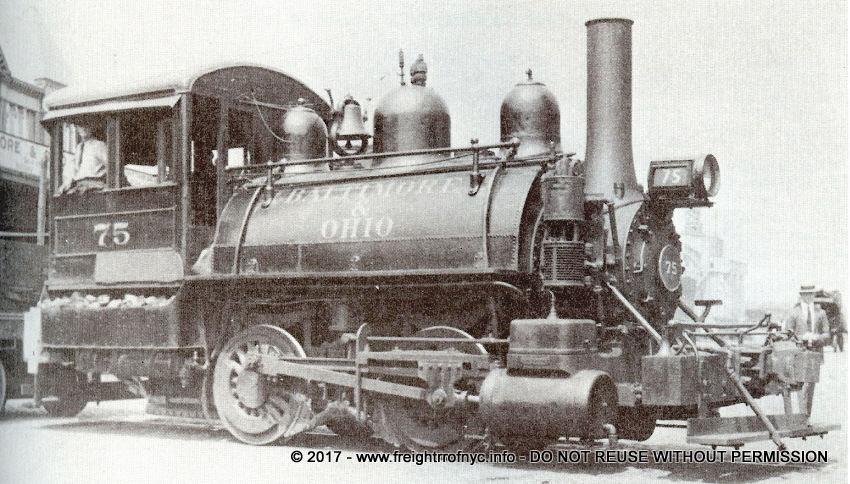
#75 on West 26th Street float bridge lead, crossing
Twelfth Avenue - unknown date
"Baltimore & Ohio four-wheel saddle tank
switching locomotive No. 75, class C-4 / 44."
"Locomotives & Cars since 1900", by Walter
A. Lucas; Simmons-Boardman Publishing,
1959
added 25 December 2011
.
It was at this point I solicited the assistance of my regular B & O historian, Ed Bommer. As usual, Ed did not let me down!
Now that IS a picture to puzzle over. B&O 75 was built by Baldwin in April 1893, serial no 13376.
The sign in the background was a puzzle too, since the piers on either side of the B & O carfloat transfer bridge were owned by other outfits, as you can see in this photo of West 26th Street, facing the Hudson in the 1920's. Ah, but here is that B & O sign! So indeed B&O 75 is at West 26th Street also in the 1920's. It sports a modern electric headlight probably recently applied.

Baltimore & Ohio West 26th Street float bridge
lead - unknown date
(looking west)
Baltimore & Ohio Railroad Valuation photo
E. Bommer collection
added 26 December 2011
.
So, thanks to Ed; we now have another steam locomotive confirmed to have operated at the Baltimore & Ohio West 26th Street Freight Station! This however raises the question, why is #75 at this location, if #316 was built specifically for this location.
Paraphrasing Ockham's Razor: "All things being equal, the simplest solution tends to be the correct one." #316 was in all likelihood out for shop servicing. As #75 was scrapped in 1931, we can ascertain that the image was taken before that and backdating a little further, as #1 / 195 was acquired in December 1925, we can infer that the above photo of #75 was taken before this date as well.
.
.
#1 / #195 / #8000
Upon the passage of the Kaufman Act in 1923, which in effect was trying to eliminate the use of steam locomotives within city limits; until it was overturned on appeal in 1926; those railroads operating with the city confines had to turn to alternate methods of motive power. This coincided with Ingersoll - Rand's development of an internal combustion boxcab locomotive.
You can read the comprehensive history of all steam locomotive restrictions for the City of New York, beginning 1834 and ending with the Kaufman Act and its repeal on the main page of this website: Steam Locomotive Regulations within the City of New York.
It is very much worth a read, because there are misconceptions or omissions about the Kaufman Act, i.e. such as it overturned as unconstitutional in 1926 and was repealed in 1930.
The first production model internal combustion boxcab locomotive, was purchased by the Central Railroad of New Jersey. It would be numbered 1000, and it became a great success.
Within months, the Baltimore & Ohio Railroad would also place an order with American Locomotive Co. / General Electric / Ingersoll - Rand to construct a internal combustion boxcab locomotive of their own, in response to those New York City air pollution ordinances for use at their Offline Terminal in Manhattan, the West 26th Street Freight Station.
This unit would be the second AGEIR Boxcab to be built, and was completed December 1925 and would be assigned Baltimore & Ohio #1. This locomotive was ALCo c/n 65980 / GE c/n 9682. It was equipped with a single 300 hp Ingersoll - Rand diesel engine. This six cylinder engine had a 10" bore by 12" stroke and operated at 550 revolutions per minute.
In 1942, this locomotive would be renumbered 195; and then in 1957 it would be renumbered again, this time to 8000.
This locomotive is currently located at the Museum of Transportation in St. Louis, Missouri.
.
#8015
This locomotive was originally numbered Baltimore & Ohio Railroad #227. This number would be changed first to 8015, and finally 9155.
This locomotive was built in October 1944, by the American Locomotive Company. This locomotive was a model S1, with c/n 72841.
.
#8302
This locomotive was a General Electric model 44 Ton. Baltimore & Ohio Railroad ordered two 44 ton locomotives from General Electric. The first: c/n 30470; was built in September 1950. The second unit: c/n 30471 was built in October 1950. These locomotives were originally numbered Baltimore & Ohio Railroad #19 and #20.
The photo shown below, shows the locomotive to wear the number 8302. This was originally #20. #20 would be renumbered 8802, then renumbered again to 8302. It is currently unknown on what date the numbers where changed.
According to Tom Flagg, this locomotive was seen in the Baltimore & Ohio Railroad's St. George Facility located in Staten Island as well. Chances are, in later years; it was carfloated to and from West 26th Street on an as need basis.
.
SIRT locomotives used for relief at West 26th Street
The following information is provided by Ed Bommer, (B & O historian):
SIRT #184, a GE 65 ton centercab. This diesel's usual assignments were Maintenance of Way duties, Clifton Shop Yard switching and as a relief engine for West 26th Yard. Renumbered 193 and repainted with striping later in 1948.
SIRT #9033, an ALCo S2 (former #489). B&O renumbered its entire locomotive fleet of steam and diesel in 1957. Steam locomotives received 3 digit numbers, diesel locomotives received 4 digit numbers, which were coded to their horsepower rating and make. Relocated off Staten Island by late 1957 to work at the Baltimore & Ohio Railroad's Green Spring, WV tie treatment plant. Sold in 1963 to Manufacturers' Equipment Co. (a used locomotive dealer). Subsequently resold to Pittsburgh Plate Glass for its New Martinsville, PA plant.
|
|
| .
. |
 #316 - June 27, 1932 - West 26th Street Yard, Manhattan, NY Note electric headlight replacing the kerosene headlamp seen in above photo. unknown photographer authors collection added 18 January 2022 |
| .
. |
|
|
| .
. |
|
|
| .
. |
|
|
| .
. |
|
|
| .
. |
|
|
| .
. |
|
|
| .
. |
|
|
| .
. |
|
|
| .
. |
|
|
| .
. |
|
|
| .
. |
|
|
| .
. |
|
|
| .
. |
|
|
| .
. |
 SIRT #9031 - ca 1960 - West 26th Street Yard / Pier 66, Manhattan, NY Anthony Garetti image Getty Images added 15 August 2025 |
| .
. |
|
|
| .
. |
|
|
| .
. |
|
|
| .
. |
|
|
.
.
West 26th Street Freight Station
(B&O) Locomotive Roster
| number / name | builder | c/n | build date |
gauge |
wheel arrangement |
model | driver dia. |
cylinders |
acquired |
disposition |
notes | ref |
| #316 | NJ Loco & Machine Works | 8/1865 | std. | 0-6-0T | 44" | 19 1/2" x 22" | rebuilt from #243 | used at W 26 Street as late as 1939? scrapped 9/1946 |
[a] | [38] | ||
| #75 | Baldwin | 13376 | 4/1893 | std. | 0-4-0T | 44" | 14" x 24" | new | scrapped 1931 | [e] | ||
| #1 / #195 / #8000 |
ALCo / GE |
65980 9682 |
12/1925 | std. | B-B | 300 hp boxcab | new | re# 195 in 1942, re# 8000 in 1957; retired 1959 sold to Max Soloman, Pittsburgh, PA? 1960: Museum of Transportation, St. Louis, MO |
[b] |
[1] [20] |
||
| #206 / #8406 |
EMD | 1104 | 8/1940 | std. | B-B | SW-1 | new #206 | class DS-3e. re# 8406 in 1957, reclassed SE-1. reclassed SW-1 in 1965. sold to Railway Equipment Leasing, Minooka, IL as RELCO # RE 508 in 4/1986. leased to Crown Zellerbach, St. Francisville, LA 10/1986. |
[d] | |||
| #255 / #227 / #8015 / #9155 |
ALCo | 72841 | 10/1944 | std. | B-B | S1 | new #255 | re# 227 5/1950 DS-9a re# 8015 1957, reclassed SA-2 re# 9155 late 1965, reclassed S-1 retired 1/1977 sold 3/30/1978, for scrap Naporano Iron and Metal, Newark NJ |
[1] | |||
| #20 / #8302 / #8802 |
GE | 30471 | 10/1950 | std. | B-B | 44 Ton | new #20 | class DS15g, re# 8302 1957. re# 8802 11/1964, reclassed SG-2 sold Lutz Iron & Steel, Warren OH, 4/10/1974. resold a few months later to Precision National, Mount Vernon IL. Presumed scrapped. |
[c] | [15] [38] |
||
| SIRT #184 / #194 / #8800 |
GE | 18011 | 9/1943 | std. | B-B | 65 Ton | new #184 | Class DS-7g re# SIRT 194 in 1948. re# 8800 early 1957, reclassed SG-1. Transferred to B&O Green Spring, WV tie plant late 1957. sold 1963 to Manufacturers Equipment Co. (dealer) resold to Pittsburgh Plate Glass, New Martinsville, PA. |
[38] | |||
| SIRT #489 / #9033 |
ALCo | 72069 | 6/1944 | std. | B B | S2 | new #489 | class DS-5a re# 9033 in 1957, reclassed SA-3 reclassed 1965 to S-2 retired by 1/1979 lettered for B&O. sold to Precision National Corp. Mount Vernon, IL 4/10/1979. |
[38] |
Locomotive Footnotes:
| [a] | built as #243, 0-8-0 w/ tender 8/1865,
by New Jersey Locomotive & Machine Works, Paterson, NJ. rebuilt 10/1886 at B&O Mount Clare Shops to D1 class 0-6-0 switcher w/ tender, renumbered 316 rebuilt 2/1898 at B&O Mount Clare Shops to 0-6-0T scrapped 9/1946
|
||
| [b] |
|
||
|
[c] |
According to J. Komanesky / Diesel Shop
roster, only two 44 ton models were ordered by the Baltimore & Ohio
Railroad. These originally were delivered as #19 and #20. Construction numbers were 30470 built 9/1950 and 30471 built 10/50. #8302 could be either of these, and further info is needed. gross h.p.: 400 hp weight: 88,000 lbs . |
||
| [d] | gross h.p: 600 hp. weight: 198,000 lbs . |
||
| [e] | Class C - 4 / 44 (Tank) weight: 68,000 lbs cylinders: 14" x 22" tractive effort: 12,500 lbs. boiler pressure: 175 lbs. |
Data and information on B&O diesels provided by E. Bommer, is from "B&O Railroad Diesel Locomotive Roster" (Second Edition - 1998) by James Mischke (Panther Hollow Press, Albuquerque, NM)
.
Being a Baltimore & Ohio Railroad operation; the Pier Stations and float bridge would have been serviced by Baltimore & Ohio Railroad tugboats, carfloats and lighters.
Keeping in mind the significant fleet of marine equipment that the Baltimore & Ohio Railroad owned and operated a Marine Roster on this website would not be beneficial or justified; and therefore will not be forthcoming.
.
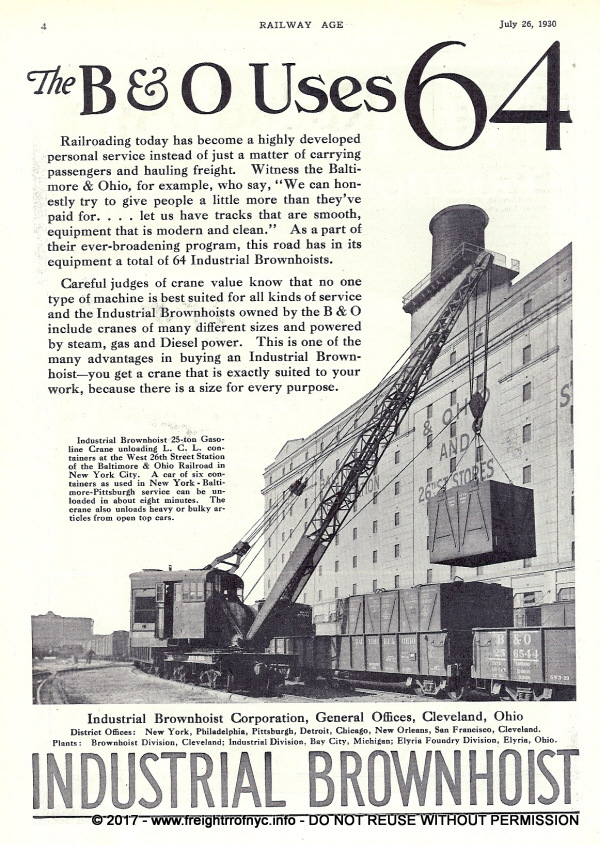
Railway Age - July 26, 1930
authors collection
added 14 Oct 2009
.
Like what you see? Suggestions?
Comments?